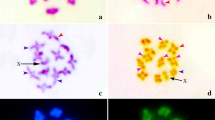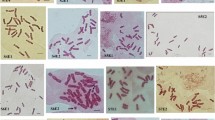Abstract
In this investigation Gloriosa superba L. was cytogenetically studied with orcein, CMA and DAPI-staining for authentic characterization. “Complex Chromocenter Type” of interphase nuclei with 3–4 bigger darkly stained heterochromatic regions was found in this species. The prophase chromosomes were “Interstitial Type” with darkly stained region at different interstitial sites of chromosomes. This species had 2n = 22 chromosomes with heterogenous centromeric formulae 14 m + 8 sm. In addition to the regular chromosomes, 1–6 small chromosomes were found in several mitotic pro-metaphase, metaphase and anaphase stage which covered 43.57% of the total cell count of this species suggesting the probable occurrence of B-chromosome. Presence of B-chromosome was probably the first report for this genus. After fluorescent banding, a pair of dot like CMA fluoresced bands were observed whereas no bright band was found in G. superba after DAPI-staining which suggested the coexistence of GC- and AT-base pairs in the genome. Thus, the compilation of the above information will be very useful for cytogenetical characterization of G. superba L. in Bangladesh.




Similar content being viewed by others
References
Ade R, Rai M. Review: current advances in Gloriosa superba L. Biodiversity. 2009;10:210–4.
Akter L, Mahbub M, Habib MA, Alam SS. Characterization of three varieties of Lathyrus sativus L. by fluorescent karyotype and RAPD analysis. Cytologia. 2015;80:457–65.
Alam SS, Khatun M, Sultana SS. Differential chromosome banding and isozyme assay in Corchorus aestuans. Bangladesh J Bot. 2011;40:47–52.
Alam SS, Kondo K. Differential staining with Orcein, Giemsa, CMA and DAPI for comparative chromosome study of 12 species of Australian Drosera (Droseraceae). Am J Bot. 1995;82:1278–86.
Ali M, Moghaddam B, Schubert V, Kumke K, Weiβ O, Klemme S, Nagaki K, Macas J, González-Sánchez M, Heredia V, Gómez-Revilla D, González-García M, Vega JM, Puertas MJ, Houben A. Nondisjunction in favor of a chromosome: the mechanism of rye B chromosome drive during pollen mitosis. Plant Cell. 2012;24:4124–34.
Bennett ST, Leitch IJ, Bennett MD. Chromosome identification and mapping in the grass Zingeria biebersteiniana (2n = 4) using fluorochromes. Chromosome Res. 1995;3:101–8.
Biswas A, Muntaha SN, Rahman MM. Comparative karyotype analysis in two life-forms of Gloriosa superba L. J Pharma Biol. 2014;4:77–80.
Bose TK, Yadab LP. Commercial flowers. Naya Prakash. 1989.
Cuellar T, Belhassen E, Fernández-Calvín B, Orellana J, Bella JL. Chromosomal differentiation in Helianthus annuus var. macrocarpus: heterochromatin characterization and rDNA location. Heredity. 1996;76:586–91.
Delay C. Recherches sur la structure des noyaux quiescents chez les Phanerogames. Rev. Cytol. et Cytophysiol Veg. 1947;9:169–222.
Galasso I, Saponetti LS, Pignone D. Cytotaxonomic studies in Vigna. III. Chromosomal distribution and reacting properties of the heterochromatin in five wild species of the section Vigna. Caryologia. 1996;49:311–9.
Guerra M. Patterns of heterochromatin distribution in plant chromosomes. Genet. Mol. Biol. 2000;23:1029–41.
Houben A. B chromosomes-a matter of chromosome drive. Front Plant Sci. 2017;8:1–6.
Islam M, Alam SS. Karyotype characterization with fluorescent banding in one released and two wild germplasms of Hibiscus cannabinus L. Cytologia. 2011;76:223–7.
Jones N, Houben A. B chromosomes in plants: escapees from the A chromosome genome? Trends Plant Sci. 2003;8:417–23.
Jones N. New species with B chromosomes discovered since 1980. Nucleus. 2017;60:263–81.
Khan MS. Towards sustainable development: conservation of genetic resources of Bangladesh, a background paper for national conservation strategies-Bangladesh. The World Conservation Union and Bangladesh Agricultural Research Council; 1995.
Khoshoo TN. Cytology of Gloriosa. Curr Sci. 1956;25:165–6.
Komissarov A, Vij S, Yurchenko A, Trifonov V, Thevasagayam N, Saju J, Sridatta PSR, Purushothaman K, Graphodatsky A, Orbán L, Kuznetsova I. B chromosomes of the Asian seabass (Lates calcarifer) contribute to genome variations at the level of individuals and populations. Genes. 2018;9:464.
Kondo T, Hizume M. Banding for the chromosomes of Cryptomeria japonica D. Don Jpn J For Soc. 1982;64:356–8.
La-Cour LF. Heterochromatin and the organization of nucleoli in plants. Heredity. 1951;5:37–50.
Levan A, Fredga K, Sandberg AA. Nomenclature for centromeric position on chromosomes. Hereditas. 1964;52:201–20.
Levin DA, Palestis BG, Jones RN, Trivers R. Phyletic hot spots for B chromosomes in angiosperms. Evolution. 2005;59:962–9.
Maroyi A, Maesen LJGVD. Gloriosa superba L. (family Colchicaceae): Remedy or poison? J. Med Pl Res. 2011;5:6112–21.
Mehra PN, Sachdeva SK. Cytological observations on some W. Himalayan Monocots: II. Smilacaceae, Liliaceae and Trilliaceae. Cytologia. 1976;41:5–22.
Miller EW. A preliminary note on the cytology of the Melanthioideae section of the Liliaceae. Proc Univ Durham Philos Soc. 1930;8:267–71.
Mitra K, Datta N. IOPB chromosome number reports VIII. Taxon. 1967;16:445–61.
Narain P. Chromosomal mosaicism in the microsporocytes of Gloriosa. Cytologia. 1980;45:271–9.
Ohta S, Saruhashi Y. Geographical distribution of B chromosomes in Aegilops mutica Boiss., a wild relative of wheat. Hereditas. 1999;130:177–83.
Padmapriya S, Rajamani K, Sathiyamurthy VA. Glory Lily (Gloriosa superba L.)—a review. Int J Curr Pharm Rev Res. 2015;7:43–9.
Ragupathi G. Phytochemical and antioxidant screening of Gloriosa superba L. from different geographical positions of South India. Int J Bot Stud. 2016;1:13–9.
Sato D. Karyotype alteration and phylogeny in Liliaceae and allied families. Jpn J Bot. 1942;12:57–161.
Schwarzacher T, Schweizer D. Karyotype analysis and heterochromatin differentiation with Giemsa C-banding and fluorescent counterstaining in Cephalanthera (Orchidaceae). Plant Syst Evol. 1982;141:91–113.
Schweizer D. Reverse fluorescent chromosome banding with Chromomycin and DAPI. Chromosoma. 1976;58:307–24.
Sharma AK, Sharma A. An investigation of the cytology of some species of Liliaceae. Genet Iber. 1961;13:25–42.
Siddiqui KU, Islam MA, Ahmed ZU, Begum ZNT, Hassan MA, Khondker M, Rahman MM, Kabir SMH, Ahmad M, Ahmed ATM, Rahman AKA, Haque EU. Encyclopedia of flora and fauna of Bangladesh. Angiosperms: Monocotyledons (Agavaceae-Najadaceae), Asiat Soc Bangladesh; 2007.
Stebbins GL. Chromosomal evolution in higher plants. Boston: Addison-Wesley publishing company; 1971.
Su H, Liu Y, Liu Y, Birchler JA, Han F. The behavior of the maize B chromosome and centromere. Genes. 2018;9:476.
Tanaka R. Type of resting nuclei in Orchidaceae. Bot Mag Tokyo. 1971;84:118–22.
Tjio JH. The somatic chromosomes of some tropical plants. Hereditas. 1948;34:135–46.
Williams E, Barclay PC. The effects of B-chromosomes on vigour and fertility in Dactylis hybrids. N Z J Bot. 1968;6:405–16.
Acknowledgements
This research work was funded by Bangabandhu Science and Technology Fellowship Trust, Ministry of Science and Technology, Government of the Peoples’ Republic of Bangladesh.
Author information
Authors and Affiliations
Contributions
SSS—Field investigation, performing the experiment, data analysis, drafting manuscript; CKD—Material collection, performing the experiment, data analysis; SSA—Study design, originator of the research, interpretation of results; MAH—Study design, interpretation of results, critical revision and finalization of the manuscript.
Corresponding author
Rights and permissions
About this article
Cite this article
Sultana, S.S., Dash, C.K., Alam, S.S. et al. Karyotype analysis and report on B-chromosome in Gloriosa superba L. by differential staining. Nucleus 62, 31–38 (2019). https://doi.org/10.1007/s13237-018-0259-2
Received:
Accepted:
Published:
Issue Date:
DOI: https://doi.org/10.1007/s13237-018-0259-2




